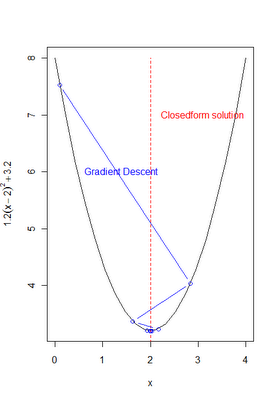Suppose you want to minimize the function 1.2 * (x-2)^2 + 3.2. Basic calculus requires that we find the 1st derivative and solve for the value of x such that f'(x) = 0. This is easy enough to do, f'(x) = 2*1.2*(x-2). Its easy to see that a value of 2 satisfies f'(x) = 0. Given that the second order conditions hold, this is a minimum.
Its not alwasys the case that we would get a function so easy to work with, and in many cases we may need to numerically estimate the value that minimizes the function. Gradient descent offers a way to do this. Recall from my previous post the gradient descent algorithm can be summarized as follows:
repeat until convergence {
Xn+1 = Xn - α∇F(Xn) or x := x - α∇F(x) (depending on your notational preferences)
}
Where ∇F(x) would be the derivative we calculated above for the function at hand and α is the learning rate. This can easily be implemented R. The following code finds the values of x that minimize the function above and plots the progress of the algorithm with each iteration. (as depicted in the image below)
R-code:
# ---------------------------------------------------------------------------------- # |PROGRAM NAME: gradient_descent_R # |DATE: 11/27/11 # |CREATED BY: MATT BOGARD # |PROJECT FILE: # |---------------------------------------------------------------------------------- # | PURPOSE: illustration of gradient descent algorithm # | REFERENCE: adapted from : http://www.cs.colostate.edu/~anderson/cs545/Lectures/week6day2/week6day2.pdf # | # --------------------------------------------------------------------------------- xs <- seq(0,4,len=20) # create some values # define the function we want to optimize f <- function(x) { 1.2 * (x-2)^2 + 3.2 } # plot the function plot(xs , f (xs), type="l",xlab="x",ylab=expression(1.2(x-2)^2 +3.2)) # calculate the gradeint df/dx grad <- function(x){ 1.2*2*(x-2) } # df/dx = 2.4(x-2), if x = 2 then 2.4(2-2) = 0 # The actual solution we will approximate with gradeint descent # is x = 2 as depicted in the plot below lines (c (2,2), c (3,8), col="red",lty=2) text (2.1,7, "Closedform solution",col="red",pos=4) # gradient descent implementation x <- 0.1 # initialize the first guess for x-value xtrace <- x # store x -values for graphing purposes (initial) ftrace <- f(x) # store y-values (function evaluated at x) for graphing purposes (initial) stepFactor <- 0.6 # learning rate 'alpha' for (step in 1:100) { x <- x - stepFactor*grad(x) # gradient descent update xtrace <- c(xtrace,x) # update for graph ftrace <- c(ftrace,f(x)) # update for graph } lines ( xtrace , ftrace , type="b",col="blue") text (0.5,6, "Gradient Descent",col="blue",pos= 4) # print final value of x print(x) # x converges to 2.0

No comments:
Post a Comment